




Pipeline for the Future High-Tech Workforce
The RHIC program constitutes a technical, scientific wellspring that feeds many fields. Maintaining such facilities keeps an ever-more-sophisticated, highly specialized workforce growing.
In addition to helping scientists peer into the very heart of matter, large-scale physics facilities like the Relativistic Heavy Ion Collider (RHIC) play a significant role in training the next generation of world-class physicists. These scientists often make important contributions that fuel the economy, provide for security, and pave the way to a healthier, brighter future. Indeed, more than half the students who earn doctoral degrees in nuclear physics in the U.S. go on to work in fields as diverse as national security, medicine, energy generation, space exploration, finance, and more.
As of 2012, more than 350 students have earned Ph.D.’s based in part on their research at RHIC; hundreds of more are in the pipeline. Here are some of their stories.
Ágnes Mócsy
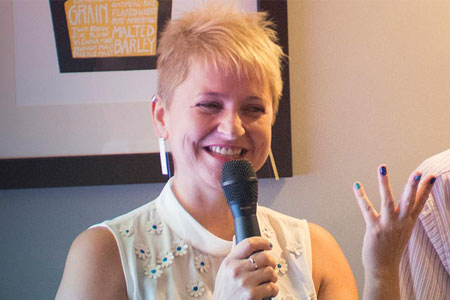
“I never forget how much in awe I was when I first saw RHIC,” said Ágnes Mócsy, a theoretical physicist and tenured associate professor at Pratt Institute, one of the world’s prestigious art and design universities. She was a graduate student at the University of Minnesota stepping into the world of experimental nuclear physics at the Relativistic Heavy Ion Collider (RHIC), a particle collider and DOE Office of Science User Facility at the U.S. Department of Energy’s Brookhaven National Laboratory, “where I could see firsthand how the theories I was working on with pen and paper were being put to the test.”
One of her many missions is to convey that sense of awe to what may seem like an unlikely audience: the art students she teaches in physics and astronomy classes for non-physics majors at Pratt.
“I work at the intersection of art and science so that I can pass my enthusiasm about the fascinating discoveries in science on to my students and instill in them scientific skepticism,” she said. “I think it’s so important to teach this to a broad audience as the best method for seeking truth in all areas of life. By teaching my students more about how the process of science is carried out, they will become more effective at addressing, evaluating, and responding to other issues in our society.”
As a graduate student, Mócsy conducted predictive studies of the particles RHIC would produce even before it started operating in 2000. After earning her Ph.D. in 2001, she continued her association with RHIC, eventually taking a position with the theory group at the RIKEN-BNL Research Center (RBRC). “When I got the job, I was so excited to finally fulfill my dream of working at Brookhaven that I left a Humboldt fellowship at the Goethe University in Frankfurt a year early,” she said.
“Working on RHIC physics has been my entryway into the world of science. This is where I learned to think like a scientist. This is where I learned how the scientific method actually works,” she said. “RHIC also helps me connect with the public. They are as inspired by this facility as I am. RHIC is a very powerful symbol of the ambitions and accomplishments of mankind.”
The desire to share that broader view of the importance of RHIC and science in general is what ultimately led Mócsy to her current role at Pratt, even after having been offered the opportunity to take a position at a research university.
“Such a position was the career goal that I had been working towards throughout my life as a physicist. The decision was an excruciating one, but in the end, I decided to turn it down for the opportunity to continue working at Pratt, where I have the chance to reach a broad audience and tap into the creative potential of my students and colleagues. My goal, besides continuing research, is to find ways to explore and create connections between the well of creativity at Pratt and the well of scientific ideas at Brookhaven.”
She frequently brings her students to RHIC for tours.
“These students, who are learning about physics and astronomy in the classroom, are very inspired by what they see. It can really be part of a transformation for them as they develop a deeper appreciation for science. In that sense, RHIC is an amazing tool not just to do physics, but also to inspire students. I’ve had students change their career paths based on their newly discovered passion for science, or have their artistic expression stirred towards science.”
As a theoretical physicist who often finds herself the only female present in meetings or seminars, Mócsy has also become a passionate advocate for minorities in physics. “In the past year I’ve been invited to talk about the value of and possible avenues for extending STEM [science, technology, engineering, and mathematics] education and careers to minorities,” she said.
To get her messages across, she has dabbled in the art of filmmaking and other forms of outreach. In 2013, she produced a short opinion/documentary film entitled “Smashing Matters,” together with a science advocacy website, to convey “the far-reaching yet incalculable value of fundamental research.” She’s brought her stories about the fun of research at RHIC to several “science café” events at pubs near Brookhaven (PubSci) and New Haven, and a theater in Manhattan. And she’s presented her views on the importance of science and RHIC in particular to members of Congress as part of the RHIC/AGS Users Executive Committee.
“I want to be an advocate for science and an advocate for big science. If RHIC did not exist, I would not have such a tangible and impressive example of science to show off!”
The impacts, she emphasizes, can be global.
“The world of physics is a highly international endeavor: we meet and work together with colleagues from all over the world, and we get to travel to far places, be exposed to such a large variety of cultures. Even countries that might otherwise not be best of friends end up working together for the common goal, that of unveiling the truth of nature.”
Debasish Das

“I had no idea before I joined the RHIC community how a large collaboration runs,” said Debasish Das, who conducted research as part of the STAR collaboration at the Relativistic Heavy Ion Collider (RHIC) while earning his Ph.D. in nuclear physics from Jadavpur University, Kolkata, India. Now an Associate Professor at Saha Institute of Nuclear Physics, Kolkata, and continuing his exploration of the intricacies of heavy ion collisions as part of the ALICE collaboration at the Large Hadron Collider, Das says his time at Brookhaven National Laboratory’s world-class collider, a U.S. Department of Energy Office of Science User Facility, taught him valuable lessons he applies and imparts to his own students today.
“My RHIC experience gave me a sense of discipline and also how to share even while retaining scientific credit,” he says. “The very thought of 500+ authors on a single paper made me feel excited and, at the same moment, apprehensive as to where I stand among them.”
He first came to Brookhaven in spring 2004 to help commission the STAR Photon Multiplicity Detector, which was built by a collaboration of Indian scientists. This detector picks up signs of photons emitted from the hot soup of quarks and gluons produced in RHIC collisions, carrying clues about the transition that freed these particles from their more usual confinement within the protons and neutrons of ordinary atomic nuclei.
“I used to commute on a cycle, which was my only mode of transport for going from the dorms in the wee hours to the STAR control room.” One day he received a call from the shift leader asking him to come over if he wanted to take some data he needed for a particular analysis. “I barely managed to reach the control room just before they were about to start. It was indeed a breathtaking experience,” he said.
Even after completing his Ph.D. in 2007, he continued working on experiments at STAR and collaborating with Brookhaven physicists as a postdoc in the University of California-Davis physics group. In 2008, he presented the first plot of “upsilon invariant mass” in heavy ions—a thermometer for measuring the temperature of the matter created in RHIC collisions—during the Quark Matter 2008 meeting, held in Jaipur, India. “I felt awed and at the same time humbled to be a part of this exciting first moment, particularly to do it in my home country. It gave me goose bumps,” he said.
“Being from this part of the world and being able to communicate with people from all parts of the world—Europe, America, even Africa—is very important, especially coming from a small town where I was born. I like talking to people from different cultures. It has been a wonderful experience for me.”
Das’ comfort with being part of a large, international group has only grown. “ALICE is even bigger than STAR, with more than 1,000 scientists.”
As the run coordinator of ALICE’s muon spectrometer during the summer of 2010, “I did not have much trouble, since the experiences to trouble shoot were already in my mind based on my RHIC days.”
“Now I often share with my juniors and students the experiences I learned from STAR/RHIC, which have helped me immensely in my current role as coordinator of a dedicated upsilon physics analysis group at ALICE.”
Young Researchers at RHIC
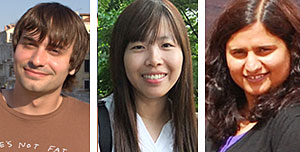
Brief stories of what some students and postdocs are doing at RHIC right now, and what drew them to research in this field.
Dan Magestro
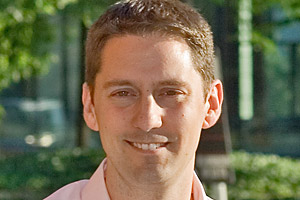
Dan Magestro
“A scientist at the core,” Daniel Magestro has applied expertise gained earning a Ph.D. in nuclear physics to a wide range of subsequent careers—from teaching to investment risk management, marketing and customer analytics, health care and supply-chain operations. “I’m driven to understand things—markets, customers, supply chains, etc.—via curiosity and data, and then leverage that increased understanding to help an organization succeed,” he said.
As the Director of Advanced Analytics for Cardinal Health’s pharmaceutical business in Columbus, Ohio, he manages the company’s usage of large data sets and advanced analysis methods to improve the cost-effectiveness of health care. He also teaches applied data analysis in the Department of Finance at Ohio State University’s Fisher College of Business.
“I love the understanding that comes from studying the world through data, distilling complex information to its simplest truths,” he said.
Magestro’s appreciation for the power of data began with his role analyzing terabytes of experimental data flowing from physics facilities—in particular, the STAR detector at the Relativistic Heavy Ion Collider (RHIC), a U.S. Department of Energy Office of Science User Facility located at DOE’s Brookhaven National Laboratory. The only operating particle collider in the United States, RHIC is used to recreate the conditions of the early universe and explore the subatomic building blocks of matter.
After earning his Ph.D. from Michigan State University, Magestro worked with a team of hundreds of scientists to extract information from thousands of particles streaming from thousands of particle collisions each second at STAR to reveal subtle details about the conditions created in those collisions—conditions that offer insight into what the universe was like just after the Big Bang and what holds matter together today.
“As a nuclear physics student, I framed problems, identified and collected the data needed, carried out the necessary analyses, innovated en route, and communicated the findings to drive decisions and next steps. All of that was carried out in collaborative, cross-functional settings where the need to simplify complex concepts was key to gaining acceptance with collaborators and the scientific community,” he said.
“In the business world, the approach has been remarkably similar.”
Whether managing risk for a pension portfolio, providing marketing advice for an insurance company or bank, or instructing undergrads in the finer points of futures trading—all of which Magestro has done—he says, “I’ve been driven by crafting and solving problems with data and with creative analyses that uniquely move something forward—understanding of nuclear matter, safer investment strategies, growth and profitability. My passion for tackling analytical problems has been the common thread from the beginning.”
Magestro is also passionate about sharing with others the extensive value that both RHIC and a first career in nuclear physics provide. “I left nuclear physics with a cool set of contributions and discoveries, and happy memories of a first career that exposed me to cultures and ideas that are deeply embedded in my worldview. My interesting career path and success in business is completely due to my time in nuclear physics.”
Lokesh Kumar
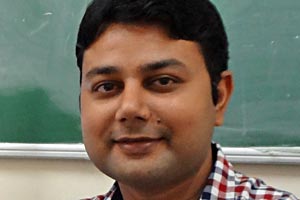
Lokesh Kumar
Lokesh Kumar recently joined the National Institute of Science Education and Research (NISER) in India. He is an active participant in the STAR experiment at Brookhaven National Laboratory’s Relativistic Heavy Ion Collider (RHIC) and the ALICE experiment at the Large Hadron Collider (LHC). Both experiments study the subatomic particle “debris” emerging from light-speed collisions of heavy ions to get clues about what matter was like at the dawn of time. Kumar’s training for this work began right here at Brookhaven, as a graduate student and then a postdoctoral fellow from Kent State University working at STAR.
“I was stationed at Brookhaven to work on the RHIC beam energy scan program, which looks at how conditions created in heavy ion collisions change by varying the energy of the colliding beams over the broad range accessible at RHIC,” he said. This versatility allows scientists to explore the transition of matter from ordinary atomic nuclei made of protons and neutrons to the 4-trillion-degree “soup” of their constituent particles—quarks and gluons—as they last existed at the beginning of the universe some 13.8 billion years ago. The goal is to better understand how this “quark-gluon plasma” evolved as the real universe cooled and condensed to form 99 percent of the visible matter that exists today—including all stars, planets, people and so on—and to search for a so-called “critical point” at which the transition between these different forms of matter moves from continuous to sudden.
“I stayed at Brookhaven for three years, from January 2010 to June 2013, which gave me the chance to discuss this research with experienced scientists and experts, greatly expanding my understanding about this field,” Kumar said.
Collisions at the LHC’s ALICE experiment occur at much higher energies than RHIC—consistently creating the quark-gluon plasma of the early universe—while RHIC can explore the energy “region” closer to and on either side of the transition.
“The two experiments are complementary, helping us explore the full range of the ‘nuclear phase diagram’—a map of what happens over a range of collision temperatures and densities,” Kumar said. “At NISER, I am one of the core members of the beam energy scan program searching for the critical point and the phase boundary to better understand the phase diagram.”
“Here in India, we are very optimistic about the success of the RHIC beam energy scan program. Already, it has provided valuable information about particle production in heavy-ion collisions and also shown different behavior for some observables when the beam energy is lowered. Possibly we will find the signatures for the critical point and the phase boundary.”
With such information, he said, our understanding of the phases of nuclear matter might be brought to the level at which we understand the phases of more familiar substances like water, where the underlying interactions are electromagnetic rather than at the level of quarks and gluons. That understanding would make the mysteries of the early universe a bit less mysterious to us all—and who knows where else it could lead?
Hoffman, Kocoloski, Miller
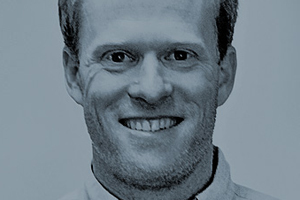
Mike Miller
As both a graduate student at Yale and a postdoctoral fellow at Massachusetts Institute of Technology (MIT), Mike Miller was immersed in analyzing data from the STAR detector at the Relativistic Heavy Ion Collider (RHIC), where thousands of particles stream out of ion collisions occurring thousands of times each second. Now, instead of gazing at data from STAR, he has his head in “the cloud”—or, more precisely, a company called Cloudant, which he founded with fellow RHIC Ph.D. students Alan Hoffman and Adam Kocoloski of MIT, to provide “cloud” database systems that software developers use over the internet.
The trio also worked together analyzing data from the Large Hadron Collider, which generates even more data than RHIC. The technology they developed for Cloudant builds on and improves the types of tools they used for dealing with vast amounts of physics data.
“Scientists spend a lot of time building the technology needed to do science,” only getting the chance to use those tools to analyze data later, Miller said.
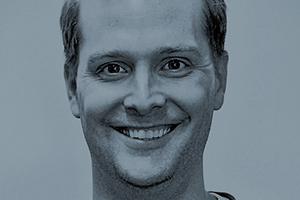
Adam Kocoloski
But that experience can have benefits, Kocoloski explained. “Because physicists and other scientists are natural problem solvers, they’re really good at thinking through what kinds of tools will work for particular data challenges,” he said. “That’s one reason we look to hire scientists to work at Cloudant.”
Cloudant has grown to 60 people now, but the company began while its founders were still working at RHIC in 2008.
“We were all leading dual lives: the life of science, and the life of a tech startup, which I wouldn’t encourage anyone to do,” said Hoffman. “But the skills we built conducting research at Brookhaven have been invaluable to what we're doing today at Cloudant.”
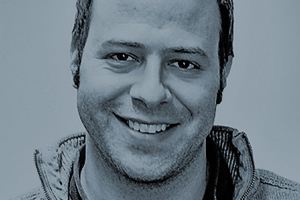
Alan Hoffman
The technology they develop may in turn have a payoff for science, by providing better tools so scientists can spend more time doing science and less time fine-tuning software. In designing tools for data management, they’re learning about many fields beyond physics, including genomics.
“Our collective thesis work at RHIC turned out to be the ideal preparation for the big data wave,” said Miller. “We didn’t realize it at the time, but the fact that we had to help invent and operate so many custom systems meant that we were at the frontier of data generation, management, and analysis. One of the most exciting things is focusing on making technology that’s broadly applicable across all domains, from consumer internet, to drug discovery and genomics. In many ways, by focusing exclusively on developing the technological tools use by scientists, we have a chance to make a much bigger impact overall.”
Johan Gonzalez
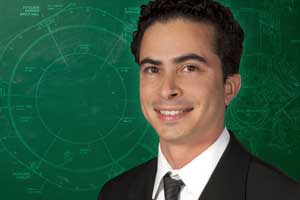
As a member of the STAR collaboration at the Relativistic Heavy Ion Collider (RHIC), Johan Gonzalez became a master juggler—of large data sets, that is. While a graduate student in physics at the University of California, Los Angeles, he developed scripting techniques for sorting and making sense of the vast amounts of data generated by collisions of particles in subatomic smashups that recreate the conditions of the early universe. Now, with Ph.D. in hand, he applies his data-juggling expertise and knowledge of distributed computer systems to design algorithms for analyzing data from radar sensors here on Earth—the kind the military use to keep us safe from more threatening "smashups."
"After I completed my Ph.D. in 2006, I got a job at Raytheon Company, a large defense contractor in Los Angeles, California," Gonzalez said. "Most of what I do involves algorithm development and analysis of radar sensor data. The algorithms that I work on essentially help get the most out of existing radar sensor hardware. I have one patent under my belt and have four more in the U.S. Patent Office pending approval."
He says the work at RHIC prepared him well, and not just for crunching the numbers.
"I learned to apply statistical techniques that I currently use in the analysis of sensor data, but some of the most valuable lessons I learned were the 'soft' skills of communicating and presenting results. By working in a large endeavor like STAR, which is comprised of hundreds of scientists and engineers, I also learned to work effectively as part of a team.
"All of these experiences have come in handy in my years of working in the private sector. But most importantly, in the STAR collaboration I was taught how to make effective use of the 'knack' that comes with being a physicist—the ability to tackle any quantifiable problem, regardless of the specific discipline."
Anuj Purwar
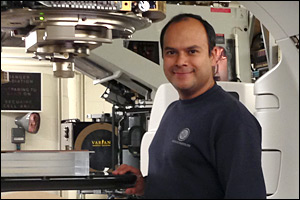
Anuj Purwar, who conducted research as a member of RHIC’s PHENIX collaboration to earn his Ph.D. in experimental nuclear physics from Stony Brook University, now applies the knowledge and skills he gained to further R&D in using radiation to treat cancer. He’s a senior staff physicist at Varian Medical Systems, based in Palo Alto, CA.
“I use my knowledge of radiation detectors, linear accelerators, and nuclear physics that I got from RHIC to come up with innovative solutions to the problem of delivering high doses of ionizing radiation to cancerous tumors while minimizing collateral damage to normal tissues,” he said.
Specifically, he works on compact linear accelerators and gaseous ionizing radiation detectors to improve the steering and focusing of cancer-killing beams and ensure that optimized doses of radiation can be delivered precisely to tumors, as well as the design of radiation shielding.
“Although there are differences—e.g., RHIC is about 2.4 miles around, operates at 200 billion electron volts, and uses superconducting magnets for beam steering, while the Varian linacs are about 1 meter long, top out at 22 million electron volts, and use ordinary electromagnets—my experience at PHENIX with accelerator physics applies directly to what I do every day.”
Purwar’s postdoc work on silicon pixel detectors and data acquisition equipment at Los Alamos National Laboratory—still as a member of RHIC’s PHENIX experiment—also has a direct bearing on his current job, as do the types of computational simulations performed for analyzing nuclear physics experimental data.
“My experience at RHIC prepared me very well for R&D in medical physics.”
Christine Nattrass
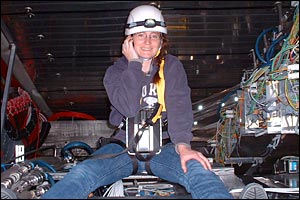
Christine Nattrass first arrived at Brookhaven as part of Yale University’s relativistic heavy ion group, where she worked on RHIC’s STAR detector.
“It's not always easy working with hundreds of collaborators who are there to critique your work. There is no way to make 500 people happy, but the product of this collaborative process is usually better than the original,” Nattrass said. “Over the course of my Ph.D., I got much better at accepting and giving constructive criticism, and I really enjoyed working with people around the world.”
After earning her doctorate, Nattrass continued her career studying particle collisions at Switzerland’s Large Hadron Collider, but remained within the RHIC community. She is now a collaborating member of ALICE, one of LHC’s detectors that, like RHIC, explores the properties of the quark-gluon plasma thought to have existed shortly after the Big Bang. She also collaborates on RHIC’s PHENIX detector.
Recently she’s expanded her expertise to teaching, as an assistant professor of physics at the University of Tennessee at Knoxville. The skills of collaboration, constructive criticism, and communication are an essential part of the job.
“What I really want to do is make science accessible to everyone—and get my students as excited about science as I am,” she said. “I think the world would be a better place if more journalists, politicians, lawyers, businessmen—everyone—had a better understanding of science.”
Monika Sharma
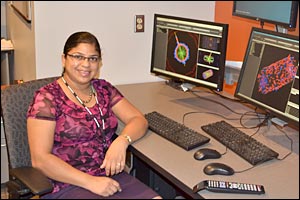
RHIC’s STAR detector was an early home to particle physicist Monika Sharma, where she first became acquainted with the massive amounts of data produced by modern-day accelerators. She worked on the state of the art RHIC computing facility (RCF) that supports computing needs of the STAR experiment and others.
“This was the first time I was working on an experiment that involved such large amounts of data,” she said. “Working on RCF was a fantastic learning curve which eventually gave me a strong foundation of analyzing data and publishing research papers in peer-reviewed journals.”
With this experience, Sharma moved on to a research associate position at physics department in Vanderbilt University, jointly working with the Advanced Computing Center for Research & Education, or ACCRE, which collects, stores, and disseminates data from the Large Hadron Collider’s CMS detector to researchers all over the world.
At ACCRE, Sharma and a team of other scientists receive shipments of terabytes of data from Geneva, where they reconstruct and store it at Vanderbilt’s Tier-2 facility. The group also stays on call 24 hours a day, 7 days a week, when CMS is active, to troubleshoot any potential data loss crises and keep systems running with minimal interruption.
“The CMS experiment at the LHC generates mountains of data in 3-4 weeks of heavy-ion running. The hands-on experience I gained working with a large-scale computing facility at RCF gave me the tools and skills I needed to approach the ever-increasing data needs at ACCRE.”
M. Munir Muniruzzaman
M. Munir Muniruzzaman transferred his skill at analyzing RHIC’s particle collisions to developing algorithms for a small company using fast neutrons to detect explosives and illicit materials such as drugs. He has worked on detectors for the Departments of Homeland Security and Defense, U.S. Customs, and a number of commercial companies.
“Then, after three years helping save lives from terrorists, I learned that a physicist can also save lives in danger of being cut short by cancer,” said Muniruzzaman. Joining a company working on a robotic radiosurgery system that directs x-rays with pinpoint precision, Muniruzzaman is now in charge of using physics-based computer simulations to calculate doses for this innovative cancer radiation treatment.
Read a longer profile of Munir Muniruzzaman recently published in Symmetry.
Andrew Hoover
Computer simulations and an understanding of radiation play a role in the work of RHIC alumnus Andrew Hoover at Los Alamos National Laboratory, where he’s helped design arrays of sensors for analyzing the composition of nuclear materials as part of an effort to track their origins and keep them out of terrorists’ hands. “My skills here are applied across several projects involving radiation detection — even a space-based gamma-ray burst experiment on a NASA mission.”
Jane M. Burward-Hoy
The space environment, filled with cosmic rays and energetic particle bursts, seems particularly well suited to the application of skills learned at RHIC. Jane M. Burward-Hoy, who now also works at Los Alamos, measures particle distributions in the outer edge of Earth’s radiation belts to more accurately predict the space “weather” environment. The ultimate goal: Help protect Earth-orbiting satellites from damage to their electronic monitoring systems — which help protect us on Earth.
Burward-Hoy attributes her career path to the terrorist events of September 11, 2001 — the day she was scheduled to defend her Ph.D. thesis. “I decided I really wanted to contribute to national security and make a difference,” she said.
Felix Matathias
RHIC alum Felix Matathias hopes to have his impact in the world of finance — using data-analysis and computing skills to pin down pricing information for rarely traded bonds in a less-than-transparent market. “Because of my work analyzing very limited early RHIC data, I was no stranger to working with sparse and rare data trying to extract a statistically significant signal. My physics training also provided me within valuable technical skills in computer programming, which I now apply every day.”
Robert Welsh
Being an outsider in a new field can be a real asset, says Robert Welsh, who transferred skills gained through 10 years of experimental particle and nuclear physics to the field of neuroscience. “My training in physics has greatly contributed to my ability to think outside the box and to learn new experimental and theoretical concepts.”
Welsh is involved in a number of studies using functional magnetic resonance imaging and other brain-scanning techniques. He specializes in tweaking experimental designs to maximize the detector’s sensitivity to the “signal” he wants to measure — for example, a change in brain activity in response to different facial expressions or cognitive tasks — for studies of psychiatric diseases such as schizophrenia and obsessive compulsive disorder, as well as amyotrophic lateral sclerosis (“Lou Gehrig’s disease”) and cancer.
